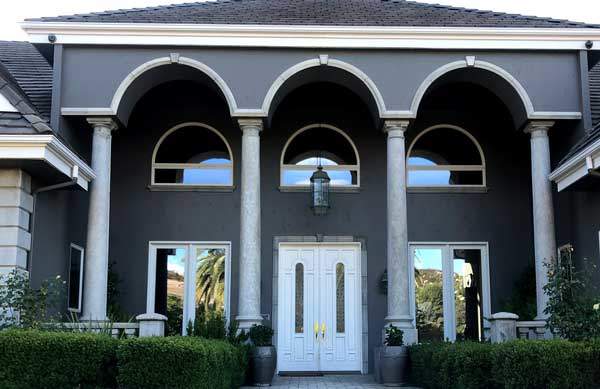Just How Residential Window Tinting Improves Your Home's Energy Effectiveness
Residential home window tinting offers an engaging option for property owners seeking to boost power efficiency within their living rooms. By using specialized films to home windows, it properly reduces warmth transfer, thereby maintaining indoor temperature levels and minimizing the demand for extreme home heating or cooling.
Recognizing Window Tinting
Understanding home window tinting is crucial for home owners looking for to enhance both convenience and power efficiency in their space. Residential Window Tint. Window tinting entails the application of a thin movie to the inside or outside surface area of glass home windows. This film can dramatically regulate the quantity of sunlight and warm that enters a home, therefore affecting interior climate problems
There are various kinds of window tinting movies offered, each with unique residential or commercial properties. Colored films soak up solar power, while reflective movies disperse it away from the glass surface area. Ceramic movies offer an equilibrium of presence and heat being rejected, making them a preferred choice amongst homeowners. The performance of home window tinting is typically gauged by its Visible Light Transmission (VLT) percent, which shows just how much light can travel through the movie.
Advantages of Power Efficiency
Home window tinting not only enhances aesthetics yet likewise plays a substantial function in enhancing power efficiency within domestic rooms. By minimizing warm transfer with windows, colored movies develop a more secure indoor climate, which can bring about significant decreases in energy intake for heating & cooling. This power efficiency converts into lower energy bills, supplying home owners with considerable lasting savings.

Furthermore, window tinting improves the comfort of living rooms. By decreasing glare and blocking damaging UV rays, colored windows develop a more pleasurable environment, which can lead to boosted wellness for passengers. The protection versus UV rays likewise helps maintain furniture and floor covering from fading, adding to the durability of home things.
Exactly How Tinting Functions
Tinting films run with a mix of advanced products and technologies designed to regulate the amount of solar power going into a home. Primarily composed of polyester, these films often integrate metallic or ceramic fragments that take in and mirror warm. This dual capability permits them to significantly lower the penetration of ultraviolet (UV) rays and infrared radiation while allowing noticeable light to go through.
The effectiveness of window tinting is gauged by its solar heat gain coefficient (SHGC), which suggests just how much solar energy is sent through the window. Reduced SHGC worths are preferable as they signify better heat being rejected. In addition, window tints can include a variety of shades, permitting homeowners to personalize their aesthetic preferences while boosting power efficiency.
Moreover, these movies function as an obstacle, avoiding warm YOURURL.com loss throughout cooler months by showing indoor heat back right into the living room. This thermal insulation effect complements the air conditioning advantages gotten throughout warmer months, adding to a balanced interior environment year-round. By handling solar energy efficiently, domestic home window tinting not only enhances convenience but additionally plays an important role in lowering power intake and decreasing utility bills.
Choosing the Right Color

There are different kinds of home window movies available, including colored, metalized, and ceramic. Ceramic movies give outstanding warm control without compromising exposure and are very sturdy, making them a prominent selection.
Visible light transmission (VLT) is another essential factor, as it indicates the quantity of natural light that can pass via the tinted glass. Homeowners ought to pick a tint with a VLT that matches their lighting choices while still providing adequate glare reduction.
Additionally, assessing the solar warm gain coefficient (SHGC) can assist identify how well a tint can obstruct heat from sunlight. A reduced SHGC shows much better heat control, ultimately improving energy effectiveness.
Installment and Maintenance Tips
Correct installment and upkeep are crucial components in taking full advantage of the advantages of residential home window tinting. Professionals additionally utilize specialized techniques and tools, which can improve the sturdiness and performance of the tint.
Complying with installation, maintenance is crucial to extend the life of the home window film. It is advised to wait at least 30 days before cleaning the tinted windows to permit the glue to treat fully.
Additionally, normal inspections are useful. Inspect for any kind of peeling or bubbling, which could show improper setup or use in time - Residential Window Tint. Dealing with these issues without delay can stop more damages and maintain power efficiency. By sticking to these installation and upkeep tips, property owners can ensure their home window tinting continues to provide significant power cost savings and convenience for website here years ahead.
Conclusion
In verdict, residential home window tinting functions as a reliable solution for boosting power effectiveness within homes. By minimizing warm transfer and obstructing hazardous UV rays, window films add to reduce power intake and improved indoor comfort. The choice of see this website ideal tinting products, along with proper installation and upkeep, further takes full advantage of these benefits. Eventually, window tinting represents a sustainable investment that not just decreases energy bills yet likewise advertises a comfy living setting throughout the year.
Window tinting involves the application of a thin film to the interior or exterior surface of glass home windows. By lowering warmth transfer with windows, colored films create an extra stable interior climate, which can lead to considerable reductions in energy consumption for heating and cooling.The efficiency of window tinting is gauged by its solar warm gain coefficient (SHGC), which shows exactly how much solar power is transmitted via the home window. By handling solar power properly, household window tinting not just enhances comfort yet likewise plays an important function in lowering energy consumption and decreasing utility costs.
By lowering warm transfer and blocking dangerous UV rays, home window films add to reduce power consumption and improved interior comfort.